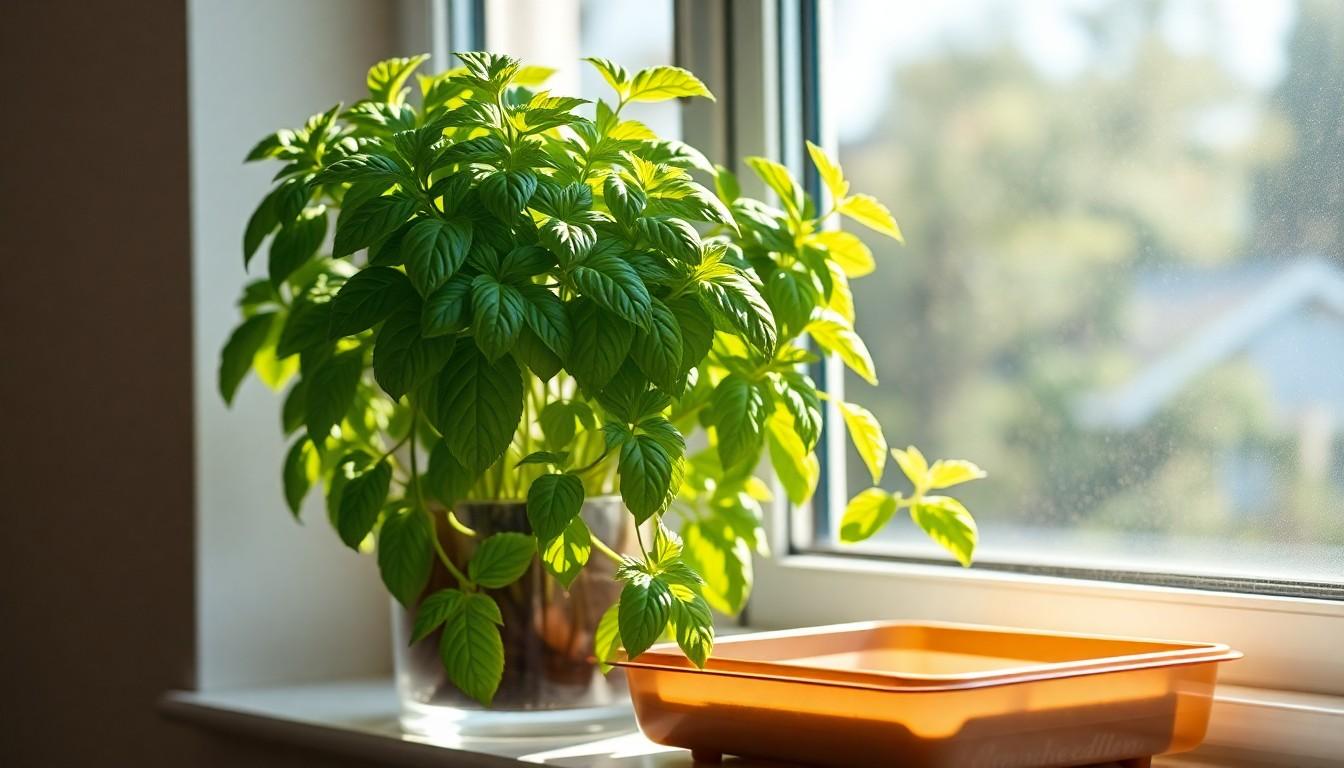Imagine this: you’re whipping up a delicious pasta dish, and the aroma of fresh basil fills the air. But wait! You don’t have any basil on hand. Don’t let that happen to you again. Growing basil indoors is not only easy but also adds a touch of greenery to your space and a burst of flavor to your meals.
Understanding Basil Plants
Basil plants thrive indoors with proper care. Familiarity with the types and benefits helps in successful cultivation.
Types of Basil Plants
Sweet basil stands as the most common variety, known for its aromatic leaves. Genovese basil offers a rich flavor, perfect for Italian dishes. Thai basil features a distinct anise scent, enhancing Asian recipes. Lemon basil provides a citrusy twist, ideal for salads and teas. Each type contributes unique qualities, making them suitable for various culinary uses.
Benefits of Growing Basil Indoors
Growing basil indoors ensures fresh access to this herb year-round. It enhances the flavor of dishes, from pasta to soups. Basil also purifies indoor air, contributing to a healthier environment. The presence of greenery adds aesthetic appeal to home spaces. Additionally, growing basil encourages gardening activities, promoting mindfulness and a connection to nature.
Essential Requirements for Indoor Basil

Indoor basil thrives with certain essential care elements. Providing the right conditions can lead to a healthy and vibrant plant.
Light Requirements
Basil plants prefer bright, indirect sunlight. Ideally, they need about 6 to 8 hours of light each day. Placing them near a south or west-facing window typically ensures sufficient illumination. If natural light is insufficient, using grow lights can supplement and promote strong growth. Rotating the plant weekly encourages even light distribution. Optimal lighting conditions support robust foliage and enhance the aromatic qualities of the leaves.
Temperature and Humidity
Basil flourishes in warm environments, favoring temperatures between 70°F and 85°F. Consistent warmth supports growth and avoids stress. Sudden temperature drops below 50°F can cause harm. Maintaining proper humidity levels is equally important, with basil preferring humidity around 40-60%. Using a humidity tray or misting the leaves can help achieve these levels. Monitoring both temperature and humidity ensures the plant remains healthy and productive indoors.
Soil and Potting
Careful consideration of soil and potting contributes significantly to the health of an indoor basil plant. Proper choices support growth and vitality.
Choosing the Right Pot
Select a pot that has drainage holes to prevent water from accumulating. Sizing matters; a pot about 6 to 8 inches in diameter accommodates a young basil plant well. Materials such as terracotta or ceramic promote breathability and keep roots healthy. Frequent repotting allows for growth; every 12 to 18 months, consider transferring basil to a slightly larger pot. Ensure that the pot’s weight provides stability to support the plant’s upright growth.
Ideal Soil Mix
A well-draining soil mix greatly benefits basil. Combine one part potting soil with one part perlite for optimal aeration. Organic matter, such as compost, enriches the mix, supplying essential nutrients. Basil prefers a soil pH between 6 to 7, which supports healthy growth. Regularly assess soil moisture by checking the top inch; ideal conditions maintain moisture without waterlogging roots.
Watering Techniques
Watering techniques play a crucial role in keeping an indoor basil plant healthy. Proper moisture levels ensure vibrant growth and flavorful leaves.
Signs of Overwatering
Overwatering can lead to root rot, a common issue for basil plants. Yellowing leaves often signal excessive moisture. Plants may also exhibit wilting, despite being soggy. Mold growth on the soil’s surface is another red flag. It’s essential to check the soil’s moisture level routinely; the top inch should feel dry before watering. Additionally, drooping stems indicate stress from too much water. Ultimately, addressing these signs ensures the plant remains vigorous.
Signs of Underwatering
Underwatering also poses risks to basil plants. Wilting leaves frequently indicate a lack of moisture. Leaves may become crispy at the edges as water deprivation increases. The soil may appear dry and crumbly, requiring immediate attention. Regularly observing these signs helps maintain optimal hydration levels. Moreover, stunted growth can occur if the plant doesn’t receive enough water. Ensuring consistent moisture prevents these issues and keeps basil thriving.
Fertilizing Indoor Basil
Fertilizing indoor basil enhances growth and flavor. Choosing the right fertilizer matters for optimal results.
Types of Fertilizers
Organic fertilizers like compost or worm castings provide essential nutrients while promoting beneficial microbes. Liquid fertilizers deliver immediate nutrients and can be easily mixed into watering schedules. Slow-release fertilizers, containing a balanced ratio of nitrogen, phosphorus, and potassium, support steady growth over time. Choosing a fertilizer with a nutrient ratio like 5-10-10 or 10-10-10 suits basil’s needs. Always verify that the product is labeled for indoor herbs to ensure safety.
Frequency of Feeding
Feeding basil every four to six weeks works well for healthy growth. Adjustments may need to occur during active growth periods, such as spring and summer. Diluting liquid fertilizers to half strength prevents nutrient burn on sensitive roots. Observing plant health helps guide feeding frequency; lush, green growth indicates adequate nutrient supply. Avoid over-fertilization, which can lead to leggy growth and decreased flavor, monitoring plants’ needs keeps them thriving.
Common Pests and Diseases
Indoor basil plants can face various pests and diseases, impacting their growth and health. Recognizing these issues early helps preserve the plant’s vitality.
Identifying Pests
Common pests affecting basil include aphids, spider mites, and whiteflies. Aphids typically cluster on tender shoots, sucking sap and stunting growth. Spider mites often cause leaf discoloration and webbing on foliage. Whiteflies, resembling tiny moths, tend to fly away when disturbed, leaving behind sticky residue. Examine leaves regularly for these signs. Damage might appear as yellow spots, curling leaves, or general wilting. Monitoring basil closely for any unusual signs ensures timely intervention.
Preventive Measures
Preventing pests involves maintaining optimal growing conditions and cleanliness. Keeping the basil plant in a well-ventilated area reduces humidity, discouraging infestations. Washing leaves with a gentle soap solution clears away pests and prevents their return. Introducing beneficial insects, such as ladybugs or predatory mites, can control pest populations naturally. Regularly inspecting the plant encourages early pest identification. Additionally, avoiding overcrowded spaces around the basil allows for proper airflow, helping prevent disease transmission. Ensuring healthy plant practices promotes resilience against pests.
Conclusion
Caring for a basil plant indoors can be a rewarding experience that enhances both culinary creations and home aesthetics. With the right light temperature and humidity conditions along with proper soil and watering techniques, anyone can cultivate a healthy basil plant. Regular fertilization and pest management are key to ensuring robust growth and flavor. By following these guidelines basil enthusiasts can enjoy fresh herbs year-round while adding a touch of greenery to their living spaces. Embracing this simple yet fulfilling gardening endeavor not only elevates meals but also promotes mindfulness and relaxation.





